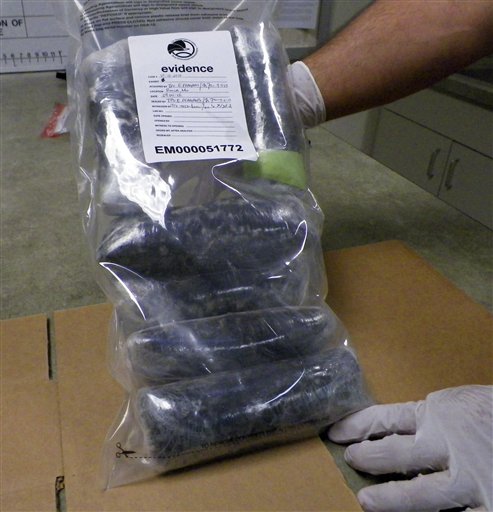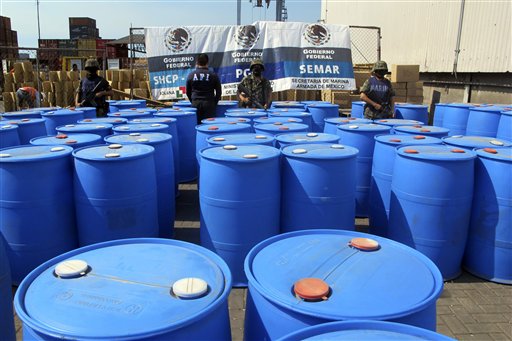ST. LOUIS — Mexican drug cartels are quietly filling the void in the nation’s drug market created by the long effort to crack down on American-made methamphetamine, flooding U.S. cities with exceptionally cheap, extraordinarily potent meth from factory-like “superlabs.”
Although Mexican meth is not new to the U.S. drug trade, it now accounts for as much as 80 percent of the meth sold here, according to the Drug Enforcement Administration. And it is as much as 90 percent pure, a level that offers users a faster, more intense and longer-lasting high.
“These are sophisticated, high-tech operations in Mexico that are operating with extreme precision,” said Jim Shroba, a DEA agent in St. Louis. “They’re moving it out the door as fast as they can manufacture it.”
The cartels are expanding into the U.S. meth market just as they did with heroin: developing an inexpensive, highly addictive form of the drug and sending it through the same pipeline already used to funnel marijuana and cocaine, authorities said.
Seizures of meth along the Southwest border have more than quadrupled during the last several years. DEA records reviewed by The Associated Press show that the amount of seized meth jumped from slightly more than 4,000 pounds in 2007 to more than 16,000 pounds in 2011.
During that same period, the purity of Mexican meth shot up too, from 39 percent in 2007 to 88 percent by 2011, according to DEA documents. The price fell 69 percent, tumbling from $290 per pure gram to less than $90.
Mexican meth has a clearer, glassier appearance than more crudely produced formulas and often resembles ice fragments, usually with a clear or bluish-white color. It often has a smell people compare to ammonia, cat urine or even burning plastic.
“You can look at it and see it has a much more pure look,” said Paul Roach, a DEA agent in Denver.
The rise of Mexican meth doesn’t mean American labs have disappeared. The number of U.S. meth labs continues to rise even as federal, state and local laws place heavy restrictions on the purchase of cold and allergy pills containing pseudoephedrine, a major component in the most common meth recipe.
The crackdowns that began a decade ago have made it more difficult to prepare large batches, so many American meth users have turned to a simpler method that uses a 2-liter soda bottle filled with just enough ingredients to produce a small amount of the drug for personal use.
But south of the border, meth is being made on an industrial scale. Sophisticated factories put out tons of the drug using formulas developed by professional chemists. The final product often is smuggled into the U.S. taped beneath tractor-trailers or hidden inside packages of other drugs.
While clandestine U.S. labs generally supply rural areas, Mexican meth is mostly targeted to urban and suburban users. Increasingly large quantities are turning up in dozens of American cities, including Dallas, Phoenix, Denver, Chicago, St. Louis and Salt Lake City, according to the DEA.
The marketing format follows a well-established pattern. By simultaneously increasing the purity and cutting the price, the cartels get people hooked and create a new customer base.
“They’re marketing geniuses,” said Jack Riley, the agent in charge of the DEA office in Chicago.
When Illinois authorities recently confiscated 1,000 pounds of Mexican marijuana, they found 10 pounds of meth hidden among the pot — essentially a free sample for the distributor to give out to drug users, Riley said.
Until recently, meth was seldom seen in major urban areas, except in biker gangs and parts of the gay community, Riley said.
“We’ve never really seen it on the street like we’ve seen cocaine and heroin,” Riley said. He worries that if the estimated 180,000 members of street gangs in Chicago get involved in meth trafficking, violence could follow.
Like the U.S., Mexico has tightened laws and regulations on pseudoephedrine, though some labs still are able to obtain large amounts from China and India. To fill the void, cartel chemists have turned to an old recipe known as P2P that first appeared in the 1960s and 1970s in some parts of the western U.S.
That recipe uses the organic compound phenylacetone. Because of its use in meth, the U.S. government made it a controlled substance in 1980, essentially stopping that form of meth in the U.S. But in Mexico, the cartels can get phenylacetone from other countries, DEA experts said.
In the third quarter of 2011, 85 percent of lab samples taken from U.S. meth seizures came from the P2P process — up from 50 percent a little more than a year earlier, DEA spokesman Rusty Payne said.
Federal agents say the influx of meth from Mexico illustrates the difficulty of waging a two-front war on the drug in neighboring countries. When one source of the drug is dealt a setback, other suppliers step in to satisfy relentless demand.
Considering the relatively untapped market of bigger American cities, the rise of Mexican meth is not surprising, said Illinois State University criminologist Ralph Weisheit, a meth expert.
“It’s something that was inevitable,” Weisheit said. “This wasn’t hard to predict.”
American authorities are not the only ones taking notice. The sharp spike in meth activity also is evident from the other side of the border. Seizures of labs and chemicals have increased nearly 1,000 percent in the past two years.
Last year, Mexican authorities made two major busts in the quiet central state of Queretaro, seizing nearly 500 tons of precursor chemicals and 3.4 tons of pure meth with a street value of more than $100 million. In Sinaloa, investigators found a sophisticated underground lab equipped with an elevator and ventilation systems as well as cooking and sleeping facilities. The facility was reachable only by a nearly 100-foot tunnel with its opening concealed under a tractor shed.
And in February, soldiers in western Mexico made a historic seizure: 15 tons of pure methamphetamine, a haul that could have supplied 13 million doses worth more than $4 billion.
The meth problem is spilling into other parts of Latin America too. In December and January, Mexican authorities seized nearly 900 tons of precursor chemicals at Mexican ports, almost all of it bound for Guatemala, which seized about 1,600 tons of meth precursors in 2011 — four times the 400 tons seized there a year earlier.
For now, cocaine remains far and away the cartels’ most profitable drug. The RAND Corp. estimates the annual street value of cocaine is about $30 billion, heroin about $20 billion and meth about $5 billion.
But cocaine is getting more expensive and less pure. According to the DEA, the price per pure gram of cocaine rose 59 percent from 2007 through September 2011. At the same time, the purity level dropped 25 percent.
Cocaine also typically comes from Colombia, meaning Mexican cartels serve as middle men who compete against each other to smuggle it into the U.S. That marginalizes their profits.
Because methamphetamine is a synthetic drug the cartels can make for themselves, the profit potential is enormous.
“It’s not plant-based,” Weisheit said. “It can be completely produced in Mexico. It’s very compact, and that makes it easy to smuggle.”
Copy the Story LinkSend questions/comments to the editors.




Success. Please wait for the page to reload. If the page does not reload within 5 seconds, please refresh the page.
Enter your email and password to access comments.
Hi, to comment on stories you must . This profile is in addition to your subscription and website login.
Already have a commenting profile? .
Invalid username/password.
Please check your email to confirm and complete your registration.
Only subscribers are eligible to post comments. Please subscribe or login first for digital access. Here’s why.
Use the form below to reset your password. When you've submitted your account email, we will send an email with a reset code.